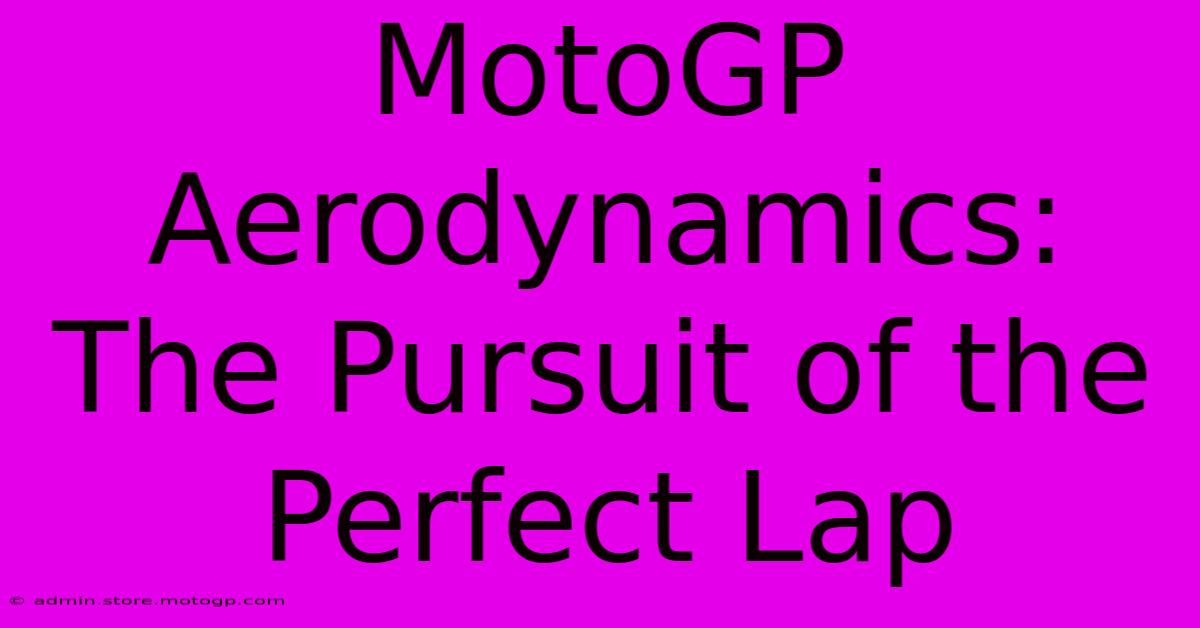MotoGP Aerodynamics: The Pursuit Of The Perfect Lap

Table of Contents
MotoGP Aerodynamics: The Pursuit of the Perfect Lap
MotoGP racing is a relentless pursuit of speed, precision, and ultimately, the perfect lap. While rider skill and engine power are crucial, a significant, often overlooked, factor contributing to success is aerodynamics. The complex interplay of air pressure, downforce, and drag significantly impacts a bike's performance, influencing cornering speeds, stability, and straight-line acceleration. This article delves into the intricate world of MotoGP aerodynamics, exploring the science behind the wings, winglets, and fairings that shape the battle for the championship.
Understanding the Aerodynamic Challenges
MotoGP bikes are designed to achieve incredibly high speeds, often exceeding 200 mph. At these velocities, aerodynamic forces become dominant, significantly affecting handling and stability. The challenge for engineers lies in balancing two opposing forces:
Downforce:
- The Grip Factor: Downforce is the downward force generated by aerodynamic surfaces, pressing the bike firmly onto the track. This increased grip is essential for achieving higher cornering speeds and stability, especially through fast, sweeping turns. Think of it like a giant hand pushing the bike down.
- The Wing Effect: MotoGP bikes utilize various aerodynamic devices, including wings and winglets, strategically placed to maximize downforce. The shape and angle of these components are meticulously designed to create a pressure difference, pushing the bike towards the track.
- The Stability Booster: Increased downforce directly translates to greater stability, allowing riders to push the bike harder and maintain control at higher speeds. This is particularly vital when entering and exiting corners at extreme lean angles.
Drag:
- The Speed Thief: Drag is the resistance a bike encounters as it moves through the air. This force opposes the bike's forward motion, slowing it down and reducing its top speed. Minimizing drag is crucial for maximizing straight-line speed.
- The Shape Matters: The design of the fairing, the motorcycle's bodywork, plays a vital role in minimizing drag. Streamlined shapes and carefully placed fairings help to reduce air resistance, allowing the bike to cut through the air more efficiently.
- The Balancing Act: The challenge is to find the optimal balance between downforce and drag. Too much downforce can dramatically increase drag, while too little downforce compromises cornering stability.
The Evolution of MotoGP Aerodynamics
Aerodynamic development in MotoGP is a continuous process of refinement. Over the years, we've seen a significant evolution:
From Simple Fairings to Complex Appendages:
Early MotoGP bikes relied on basic fairings to minimize drag. However, the introduction of winglets and then larger wings revolutionized the sport. This development was driven by the need to enhance stability and allow riders to push the limits of cornering speed.
Computational Fluid Dynamics (CFD):
Modern aerodynamic design relies heavily on CFD simulations. These powerful computer models allow engineers to virtually test different designs and optimize their performance before even building a physical prototype. This process saves time and resources, accelerating the development cycle.
Wind Tunnel Testing:
Despite advancements in CFD, wind tunnel testing remains a crucial part of the aerodynamic development process. This allows engineers to validate their simulations and fine-tune the designs based on real-world data. The wind tunnel provides invaluable insights into the airflow around the bike, revealing areas for improvement.
The Future of MotoGP Aerodynamics
The pursuit of the perfect lap continues, pushing the boundaries of aerodynamic innovation. We can expect to see:
- More sophisticated designs: Expect further refinement of existing aerodynamic aids, along with exploration of new and innovative technologies.
- Increased use of data: The increasing reliance on data analytics will allow teams to fine-tune aerodynamic setups based on track-specific conditions and rider feedback.
- Sustainable solutions: The focus on sustainability will influence the materials and manufacturing processes used in the creation of aerodynamic components.
In conclusion, MotoGP aerodynamics is a complex and dynamic field, constantly evolving to push the limits of performance. The ongoing interplay between downforce and drag, and the relentless pursuit of optimization through CFD, wind tunnel testing, and rider feedback, ensures that the fight for the perfect lap continues to be a fascinating battle of technological innovation.

Thank you for visiting our website wich cover about MotoGP Aerodynamics: The Pursuit Of The Perfect Lap. We hope the information provided has been useful to you. Feel free to contact us if you have any questions or need further assistance. See you next time and dont miss to bookmark.
Featured Posts
-
Tnt Moto Gp Inside The Minds Of Champions
Feb 18, 2025
-
Get Ready For Race Day Understanding Moto Gp Qualifying
Feb 18, 2025
-
Cota Gifts More Than Just Souvenirs
Feb 18, 2025
-
Accident Moto Gp How Riders Manage Fear
Feb 18, 2025
-
Moto Gp Accident The Importance Of Fan Support
Feb 18, 2025
